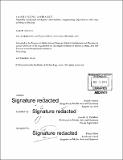| dc.contributor.advisor | Joseph A. Paradiso. | en_US |
| dc.contributor.author | Azaria, Asaph | en_US |
| dc.contributor.other | Program in Media Arts and Sciences (Massachusetts Institute of Technology) | en_US |
| dc.date.accessioned | 2017-03-20T19:40:48Z | |
| dc.date.available | 2017-03-20T19:40:48Z | |
| dc.date.copyright | 2016 | en_US |
| dc.date.issued | 2016 | en_US |
| dc.identifier.uri | http://hdl.handle.net/1721.1/107575 | |
| dc.description | Thesis: S.M., Massachusetts Institute of Technology, School of Architecture and Planning, Program in Media Arts and Sciences, 2016. | en_US |
| dc.description | Cataloged from PDF version of thesis. | en_US |
| dc.description | Includes bibliographical references (pages 117-124). | en_US |
| dc.description.abstract | Cues from the physical environment are constantly sensed and interpreted - unconsciously finding their way into our cognitive schemas and influencing our perceptions and experiences. Manipulating them has been shown to be powerful, affecting cognitive performance, mood and even physiology. Inspired by this, we propose a workspace capable of dynamically transforming its ambiance. This work presents the Digital Cubicle - a cubicle workspace which uses lighting, video projection and sound to manipulate its physical characteristics. A set of software tools is developed to create digital compositions in such a workspace, basing the compositions on objective physical measures from existing popular workspaces. Through a set of user studies, we evaluate how these elicit occupant perceptual, cognitive and physiological responses. Detailed in this work, are physiological responses indicating stress development and restoration, with interesting implications for health and wellbeing applications. We develop a sensor data collection infrastructure to complement the workspace's controllable ambiance, with rich, real-time information about the occupant context and state. Leveraging Reinforcement Learning techniques, we present a framework to devise adaptive control agents. These utilise sensor data to recommend and transform the workspace ambiance in a closed-loop fashion. A prototype intelligent agent is implemented, optimising for occupants' heart rate recovery, yet counterbalancing for occupants preferences and requests. Through evaluative simulations, anchored with real occupant data, we demonstrate and discuss the effectiveness of our proposed approach. | en_US |
| dc.description.statementofresponsibility | by Asaph Azaria. | en_US |
| dc.format.extent | 124 pages | en_US |
| dc.language.iso | eng | en_US |
| dc.publisher | Massachusetts Institute of Technology | en_US |
| dc.rights | MIT theses are protected by copyright. They may be viewed, downloaded, or printed from this source but further reproduction or distribution in any format is prohibited without written permission. | en_US |
| dc.rights.uri | http://dspace.mit.edu/handle/1721.1/7582 | en_US |
| dc.subject | Program in Media Arts and Sciences () | en_US |
| dc.title | Intelligent ambiance : digitally mediated workspace atmosphere, augmenting experiences and supporting wellbeing | en_US |
| dc.title.alternative | Digitally mediated workspace atmosphere, augmenting experiences and supporting wellbeing | en_US |
| dc.type | Thesis | en_US |
| dc.description.degree | S.M. | en_US |
| dc.contributor.department | Program in Media Arts and Sciences (Massachusetts Institute of Technology) | en_US |
| dc.identifier.oclc | 974646398 | en_US |
